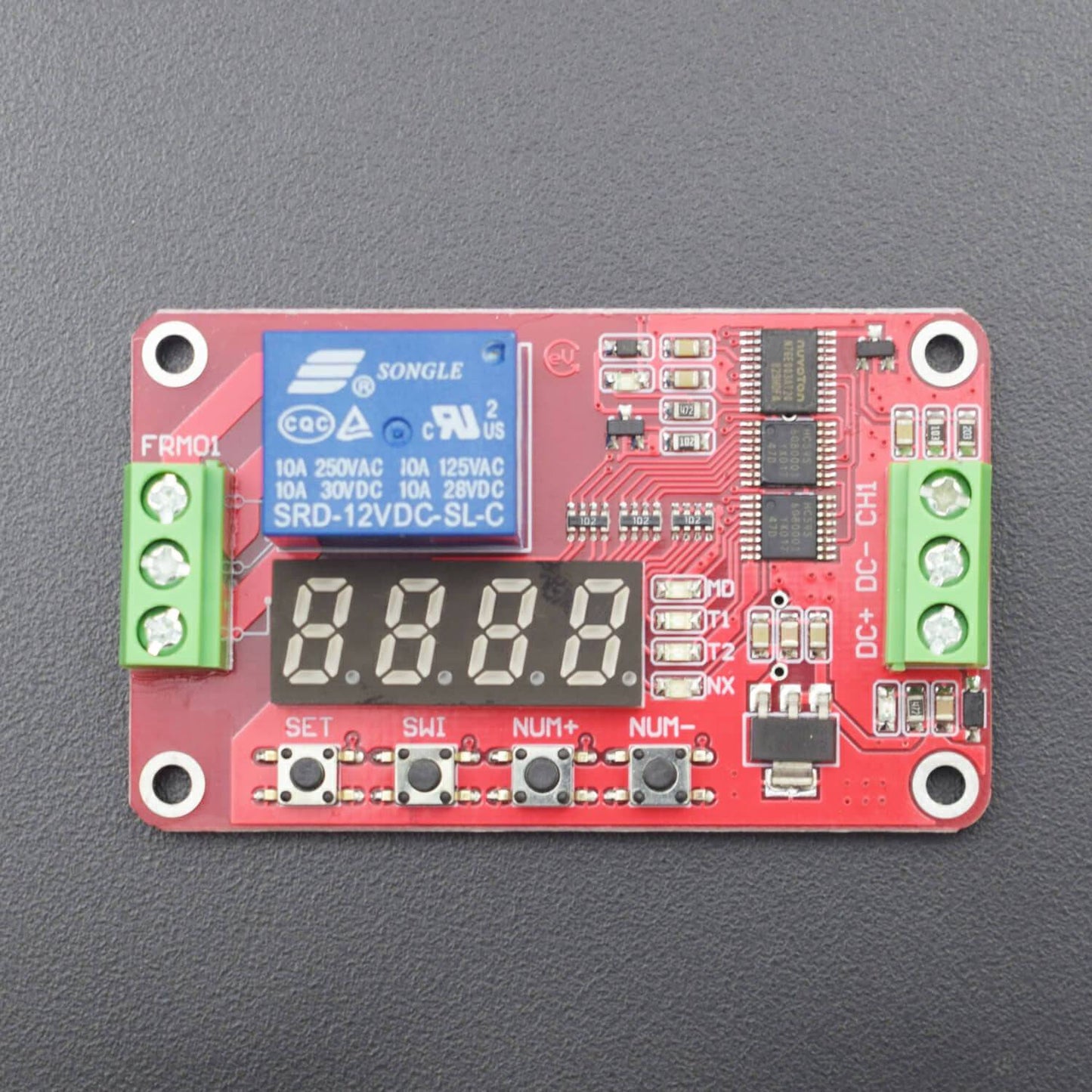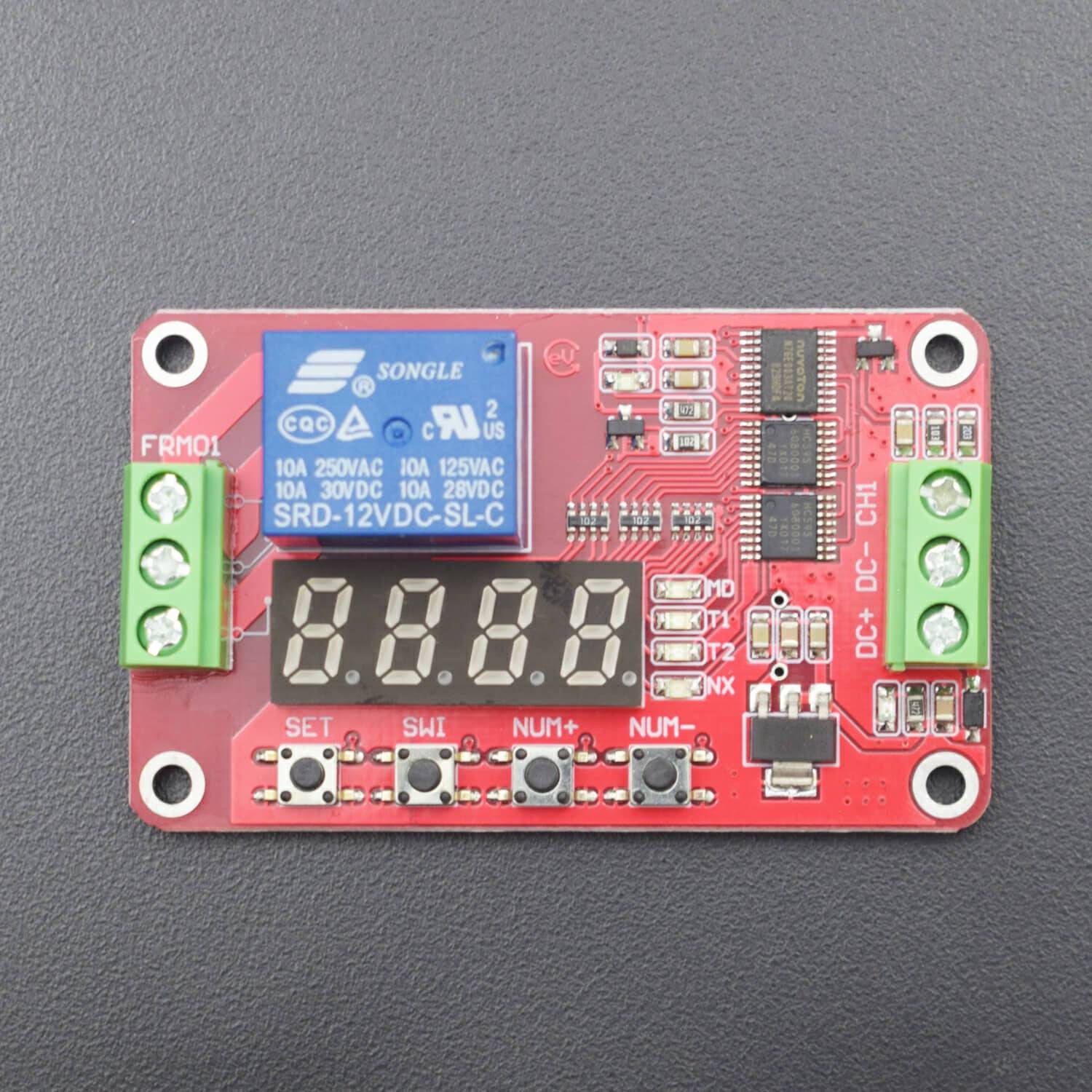
- Operating voltage: DC 5V, 12V, 24V
- Working Current: less than 5V 180mA
- 12V is less than 90mA
- Working temperature: Recommended -20 -60
- Load capacity: normally open relay ports Maximum load capacity: DC 0-30V / 10A, AC 0-250V / 10A
- Relay normally closed port maximum load capacity: DC 0-28V / 10A, AC 0-125V / 10A
DESCRIPTION
FRM02 type two-channel multifunction relay control module, designed specifically for a variety of users with different needs, the use of micro-controller as the master unit, preset up to 18 kinds of functions, and can bebased on user needs, customize and add other specific functions .
FEATURES
1 With 2-channel input and output control, each channel can be set separately 18 kinds of features to meetthe needs of more applications.
2 Has a power anti-reverse feature, power will not damage the module wrong.
3 Uses top-quality high-voltage power supply modules, the system is more stable and reliable.
4 Minimum timer function can be set to 0.1 seconds, timing accuracy of better than 0.01 seconds.
5 Increase in automatic power saving feature, users can set their own.
6 All settings option to automatically save the contents of non-volatile setting.
MODULE FUNCTION
Function 1:
Timing Pick: After power, time delay relay pull T1, T1 between 0.1 seconds -270 hours adjustable, CH1interface to a high level pulse signal, repeat the above functions;
Function 2:
Timing off: when the power relay, time delay relay disconnected T1, T1 between 0.1 seconds -270 hours adjustable, CH1 interface to a high level pulse signal, repeat the above functions;
Function 3:
Timing pull off again: After power relay to not pull, the delay time T1 reaches the relay is energized; pull the relay off after T2 arrival time, delay time T1 and T2 in 0.1 seconds -270 hours between adjustable to CH1interface a high pulse signal, repeat the above functions;
Function 4:
Timing and then pull off: After power, immediately pull the relay, the relay off delay time T1 after arrival; T2arrive after disconnecting time relay, -270 hour in 0.1 seconds delay time between T1 and T2 adjustable toCH1 interface a high pulse signal, repeat the above functions;
Function 5:
Infinite loop timing mode 1: After power relay to not pull, after the delay time T1 reaches the relay is energized; pull the relay off after time T2 arrives, and then repeat the above condition, the delay time T1 andT2 at 0.1 adjustable between second -270 hours, giving a high level pulse signal CH1 interface, you canrestart the above functions;
Function 6:
Infinite loop timing mode 2: After power, immediately pull the relay delay time T1 reaches the relay off; arriveafter disconnecting time T2 relay, and then repeat the above condition, the delay time T1 and T2 in 0.1 seconds adjustable between -270 hours, giving a high level pulse signal CH1 interface, you can restart the above functions;
Function 7:
Finite loop timing mode 1: After power relay to not pull, the delay time T1 reaches the relay is energized; pulloff the relay arrival time T2, and then repeat the NX times above the state, this time in T1 and T2 adjustablebetween 0.1 seconds -9999 seconds NX cycles adjustable between 1-9999 times, giving a high level pulsesignal CH1 interface, you can restart the above functions;
Function 8:
Finite loop timing mode 2: After power, immediately pull the relay delay time T1 reaches the relay off; arriveafter disconnecting time T2 relay, and then repeat the NX times more state, then T1 and T2 at 0.1 adjustablebetween second -9999 seconds NX cycles adjustable between 1-9999 times, a high-level interface to CH1pulse signal, the above functions can be re-started;
Function 9:
Latching relay modes: CH1 interface to relay a high level pulse signal, relay, give a high pulse signal relaydisconnected.
Function 10:
Trigger relay mode: with delay off function after power relay does not act, a high signal to CH1 interface, the relay immediately pull, the CH1 signal disappears, the relay still pull, pull-time T1 after the arrival relayinterrupted, and the T1 is adjustable between 0 seconds -270 hours.
Note: This feature, if T1 is set to 0 seconds, it becomes: CH1 have high signal relay, no signal is immediatelydisconnected.
Function 11:
Pull the trigger timing: After power relay does not act, a high-level interface to CH1 pulse signal, the delaytime relay pull T1, T1 between 0.1 seconds -270 hours adjustable, repeating a high level interface to CH1pulse signal, repeat the above function;
Function 12:
Trigger timing off: After power relay does not act, a high-level interface to CH1 pulse signal relay, the relay offdelay time T1, T1 between 0.1 seconds -270 hours adjustable, repeat to CH1 interface a high pulse signal,repeat the above functions;
Function 13:
Pull the trigger timing then disconnect: After power relay does not act, CH1 interface to a high level pulsesignal, the delay time T1 reaches the relay is energized; pull the relay off after T2 arrival time, delay time T1and T2 between 0.1 seconds -270 hours adjustable, repeat CH1 interface to a high level pulse signal, repeatthe above functions;
Function 14:
Disconnect and then pull the trigger timing: After power relay does not act, a high-level interface to CH1 pulse signal, immediately pull the relay, the relay off delay time T1 after arrival; T2 arrive after disconnecting timerelay, delay time between T1 and T2 in 0.1 seconds -270 hours adjustable, repeat CH1 interface to a high level pulse signal, repeat the above functions;
Function 15:
Infinite loop timing mode 1: After power relay does not operate to a high level pulse signal CH1 interface, thedelay time T1 reaches the relay is energized; pull off the relay arrival time T2, and then repeat the abovecondition, the extension when the time between T1 and T2 in 0.1 seconds -270 hours adjustable, repeat CH1interface to a high level pulse signal, the above functions can be re-started;
Function 16:
Infinite loop timing mode 2: After power relay does not act, a high-level interface to CH1 pulse signal,immediately pull the relay, the relay off delay time T1 after arrival; break time T2 after reaching relay, thenrepeat the above condition, the delay time between T1 and T2 in 0.1 seconds -270 hours adjustable, repeatCH1 interface to a high level pulse signal, the above functions can be re-started;
Function 17:
Finite loop timing mode 1: After power relay does not act, a high-level interface to CH1 pulse signal, thedelay time T1 reaches the relay is energized; pull the relay off after time T2 arrives, and then repeat the above state NX times , this time between T1 and T2 in 0.1 seconds -9999 seconds adjustable cycles NXadjustable between 1-9999 times, repeating to a high level pulse signal CH1 interface, you can restart the above functions;
Function 18:
Finite loop timing mode 2: After power relay does not act, CH1 interface to a high level pulse signal,immediately pull the relay, the relay off delay time T1 after arrival; break time T2 after reaching relay, thenrepeat NX times above the state, this time between T1 and T2 in 0.1 seconds -9999 seconds adjustablecycles NX adjustable between 1-9999 times, repeating to a high pulse signal CH1 interface, you can startover again function.
MODULE INTERFACE
- DC +: DC power positive
- DC-: DC power supply negative
- CH1: an input signal detection interface
- CH2: Input Signal Detection Interface 2


